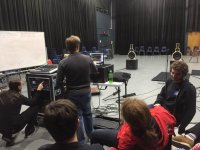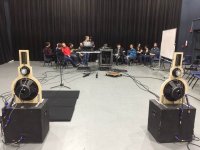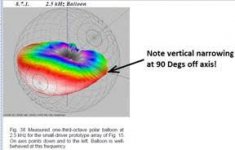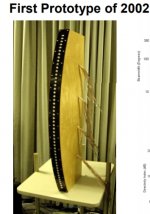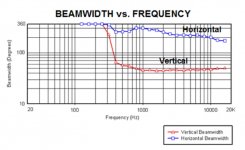A CBT is symmetrical at front and rear. It may seem like its focussed on the rear (due to arc), however acoustically its similar in both directions. At front, the arc produces certain phase shift from each driver, on the rear the arc produces the same phase shift from the same driver. Its the phase shift that creates the directivity. See full 360 degree vertcial polars in "Fig. 15 (f) Vertical polars in http://www.xlrtechs.com/dbkeele.com/PDF2/Keele (2000-09 AES Preprint) - CBT Paper1.pdfIn the forward lobe, the CBT is an expanding array.
But in the backwards lobe, it's actually focused on the back wall. (To the back, it's a focused array.)
That brings up another interesting point, if the forward arc'ed array is legendre shaded, it too becomes a CBT. Correct Patrick??
Last edited:
while I long ago heard a CBT demo at a joint AES, BAS meeting, there wasn't anything to compare to
the floor reflection image extending the array is obvious, but do we want the 'niceness' of the CBT approximating a spherical cap when the virtual center point is on the floor behind the speaker?
monkey coffins on sticks suggest floor (and ceiling?) comb filtering dosen't annoy many enough to do anything about it
I've also heard a tall line souce in a heavily treated, low ceiling room which gave very clear imaging - but the effect was all over the place from recording to recording - as expected with pan potted mixes dominating commercial stereo source
the floor reflection image extending the array is obvious, but do we want the 'niceness' of the CBT approximating a spherical cap when the virtual center point is on the floor behind the speaker?
monkey coffins on sticks suggest floor (and ceiling?) comb filtering dosen't annoy many enough to do anything about it
I've also heard a tall line souce in a heavily treated, low ceiling room which gave very clear imaging - but the effect was all over the place from recording to recording - as expected with pan potted mixes dominating commercial stereo source
Haha no kidding....on a more serious note aesthetics and price-point are indeed the two driving factors in what we do as well. Here is what we have been playing with lately: Dipole low/mid transitioning to cone beaming to waveguide control. They work great because they put the singer(wearing an omni mic) right in the dipole null. Makes life a lot easier.. Here is a video where I'm demo'ing the idea for a show we are working on.
https://www.youtube.com/watch?v=HlYiIho5c1A
Brett
Thanks for the video - you could do a dipole CBT.
Concerning a Dipole CBT:
I had a short discussion with Don Keele at the July MWAF meeting at Parts Express. He has a October 18-21 2017 AES Convention Paper on "Constant Directivity Circular-Arc Arrays of Dipole Elements" scheduled for presentation. The research is joint with Richard Taylor and Kurtis Manke of Thompson Rivers University in Kamloops, B.C. Canada. Asst. Professor Taylor and his student Manke have a short paper at the AES Convention on "Implementation of a Dipole Constant Directivity Circular-Arc Array" which describes a 10 element dipole CBT array.
Hang on it is coming.
Jim
I had a short discussion with Don Keele at the July MWAF meeting at Parts Express. He has a October 18-21 2017 AES Convention Paper on "Constant Directivity Circular-Arc Arrays of Dipole Elements" scheduled for presentation. The research is joint with Richard Taylor and Kurtis Manke of Thompson Rivers University in Kamloops, B.C. Canada. Asst. Professor Taylor and his student Manke have a short paper at the AES Convention on "Implementation of a Dipole Constant Directivity Circular-Arc Array" which describes a 10 element dipole CBT array.
Hang on it is coming.
Jim
The most important response issue of CBTs, which have been archieved by frequency-independent shading, as shown by Don, is spatial aliasing frequency, where the CBT starts to fall into pieces. Also considering the efficiency issue of frequency-independant shading, where outer drivers sit around idle, while inner ones are stressed, I rather use frequency-dependant shading. Cross-overs of first order will do.
Thanks for the video - you could do a dipole CBT.
Rick that is what I was thinking too.....And apparently Keele is already on it!
Last edited:
Rick that is what I was thinking too.....And apparently Keele is already on it!
Yes, I've read the paper. For your situation there are some challenges though. I have worked on a home version but the driver cost is really high.
Yes, I've read the paper. For your situation there are some challenges though. I have worked on a home version but the driver cost is really high.
Rick I was contemplating something based on the Dayton AMTPRO-4, which I think would work pretty well as we already use them in our Linkwitz inspired dipoles. The issue is the midwoofers; I'm thinking with the shading and trying to overcome the dipole loss smallish woofers are going to run out of steam pretty quick. I wonder if I can get away with 8 inchers and cross hard about 1.2k????
Pic of our AMT dipole prototypes....which are ok but have issues. One problem is the narrow vertical on that ribbon, which is what got me thinking about these CBT's in the first place.
Thanks for your thoughts Rick.
Brett
Attachments
It does not avoid the floor, it uses those reflections to make up the other half of the array. Big difference. That makes it 'seem' to avoid the floor. Its a good concept which emulates a wave front as if it were comming from the center of the array's arc.
But that does not detract anything from what I was saying. Which was all positive by the way.
You're correct, the CBT uses the floor to negate the normal cancellation you get with a conventional point source.
Need to clear up a few things. The 3D balloon that I showed was of 1 m tall CBT prototype, 60° circular arc. and 45° vertical beamwidth. Polars and balloons were measured at a distance of 6 m in JBL’s “Arena” test lab.As I said in post 33, " In the cbt24, the sound begins to wrap around the enclosure at 3khz, due to the narrow baffle width."
Your measurements reflect this:
1) above 3khz, there is little output to the rear of the loudspeaker, because the baffle is constraining the horizontal beamwidth to 180 degrees
2) Below 3khz, the sound wraps around the enclosure, which is why the horizontal beamwidth below 3khz gets wider and wider. By 1khz the horizontal beamwidth is about 360 degrees.
So this small prototype becomes wider much earlier in frequency.
Below is an answer from Don Keele.
1) above 3khz, there is little output to the rear of the loudspeaker, because the baffle is constraining the horizontal beamwidth to 180 degrees
NO!
The array was measured as is and as shown, no half-space flat baffle in front or rear! The reduced rear output is just the standard behavior of a CBT array!
In the balloons, notice how the vertical coverage narrows as you go off axis horizontally. It actually reaches a minimum at plus-minus 90 Degs! This is a characteristic of all circular-arc arrays, not only CBT!
Note: For the ground-plane CBT36 array, this narrowing occurs at floor level! Effectively the bottom of the following balloon is cut off! This is why the horizontal coverage of a CBT array that sprays the side walls is much reduced compared to a conventional speaker, the vertical coverage is very narrow at the sides!
The horizontal beamwidth of CBT36 is 180°, 90° to each side as shown earlier in another post. But only at a certain height as Don points out, it get's narrower at the bottom. So it's not omni, unless you define 180° as omni. Personally I regard a speaker that's close to 360° being omni.
Attachments
Go figure, reduced reflections of the side walls compared to conventional speakers. Can anyone figure out why? It isn't magic.
For the ground-plane CBT36 array, this narrowing occurs at floor level! Effectively the bottom of the following balloon is cut off! This is why the horizontal coverage of a CBT array that sprays the side walls is much reduced compared to a conventional speaker, the vertical coverage is very narrow at the sides!
Don is looking at the total reflected energy here, not necessarily the reflections you get exactly at the sweetspot. While a ground plane CBT like CBT36 and 24 have a wide dispersion, they only have it in a small vertical area. As you go down, the dispersion becomes narrower and narrower. While a traditional speaker will be fairly wide in a large vertical area, thus probably spraying the side walls more in total.
However, in the sweetspot you do get reflections from both side walls at ear height with the ground plane CBT36 and 24. And it needs to be treated if one wants the absolutely best imaging, as oppose to a more spacious sound field. A matter of taste. The nice thing about CBT is that it does have a correct tonality even with the side wall reflections due to it's uniformity. And with reflections below a minimum of -20 dB in the vertical plane, the speaker sounds good with little or no treatment in a small room.
A conventional speaker will need much more treatment to sound decent.
while I long ago heard a CBT demo at a joint AES, BAS meeting, there wasn't anything to compare to
the floor reflection image extending the array is obvious, but do we want the 'niceness' of the CBT approximating a spherical cap when the virtual center point is on the floor behind the speaker?
monkey coffins on sticks suggest floor (and ceiling?) comb filtering dosen't annoy many enough to do anything about it
I've also heard a tall line souce in a heavily treated, low ceiling room which gave very clear imaging - but the effect was all over the place from recording to recording - as expected with pan potted mixes dominating commercial stereo source
True, the floor and ceiling reflections are something we all have endured, but we never had much of an alternative. Having used CBT's in various environments I think the improved room interface certainly helps. You can also vary the scale (height) to suit your listening preferences. I do find them more realistic sounding than a tall un-shaded array.
Rick I was contemplating something based on the Dayton AMTPRO-4, which I think would work pretty well as we already use them in our Linkwitz inspired dipoles. The issue is the midwoofers; I'm thinking with the shading and trying to overcome the dipole loss smallish woofers are going to run out of steam pretty quick. I wonder if I can get away with 8 inchers and cross hard about 1.2k????
Pic of our AMT dipole prototypes....which are ok but have issues. One problem is the narrow vertical on that ribbon, which is what got me thinking about these CBT's in the first place.
Thanks for your thoughts Rick.
Brett
Sorry for my late reply. That's a tough combination but you might find it acceptable for your needs. Have you ever listened to the JBL Eon system?
Sorry for my late reply. That's a tough combination but you might find it acceptable for your needs. Have you ever listened to the JBL Eon system?
Rick I'm not quite following you--what does a JBL Eon have anything to do with what we're talking about here? What is a tough combination?
Rick I'm not quite following you--what does a JBL Eon have anything to do with what we're talking about here? What is a tough combination?
I was just curious if you had heard their portable line array. I have some friends who need a similar type system for ease of setup and portability.
In regards to your proposed design I was thinking of driver spacing, coverage, impedance, etc. - many things to consider.
I've not heard the JBL Eon, but I am well versed in the Bose and have owned the K-Array($$$$$) KR systems. They are small and portable, but ignore the elephant in the room, just like all of these systems: **low frequency and mid-bass pattern control**. All I want is a speaker that illuminates a room roughly similar to how a real instrument does. In theatrical sound that is the goal.
Despite Keele's, and other's, claims of broadband pattern control, none of them actually achieve any semblance of pattern control in the lower octaves, vertical or horizontal. In the horizontal, 180 degrees from 600hz up and 360 degrees 600hz down is NOT constant directivity in my book, while the upper octaves are 120 degrees or less. Can you imagine what a sonogram for those looks like? Klingon "Bird of Prey" comes to mind.
Last time I checked there are five octaves between 20hz and 640 hz. That is half of the audible spectrum.
Obviously those of us in PA/Theatrical audio benefit from mid-bass pattern control. Could it be that the holy grail of home audio is an Econowave design with a dipole bass section??? For theatre sound that seems to be the case.
Brett
Despite Keele's, and other's, claims of broadband pattern control, none of them actually achieve any semblance of pattern control in the lower octaves, vertical or horizontal. In the horizontal, 180 degrees from 600hz up and 360 degrees 600hz down is NOT constant directivity in my book, while the upper octaves are 120 degrees or less. Can you imagine what a sonogram for those looks like? Klingon "Bird of Prey" comes to mind.
Last time I checked there are five octaves between 20hz and 640 hz. That is half of the audible spectrum.
Obviously those of us in PA/Theatrical audio benefit from mid-bass pattern control. Could it be that the holy grail of home audio is an Econowave design with a dipole bass section??? For theatre sound that seems to be the case.
Brett
What about a tall CBT with cardioid mid and a waveguide on the tweeters? Of course you'd still have the increase in vertical baeamwidth below a certain frequency, but if the array is sufficiently tall you may be able to push that to around the Schroeder frequency of you room. If I ever build a speaker for the hobby again, that would probably be it.
My spanish guitar radiates the bass and tenor in all directions. Even an uprite bass does not beam the bass range. It takes a piano or something bigger to do so, but then it ain't clear to me where the sound is going, uprite piano versus concert piano, lid closed versus open. Tell me of one musical instrument, which is a strait dipole or cardioid with its radiation axis pointing to the listener.All I want is a speaker that illuminates a room roughly similar to how a real instrument does.
Last edited:
Drums, cymbals, strings, harp come to my mind. But that is just theoretization and has nothing to do with sound reproduction at home. https://users.aalto.fi/~ktlokki/Publs/patynen_aaua_2010.pdf
Summary
The sound radiation patterns of musical instruments represent a considerable part of the perceived room acoustics.
The directivities of fourteen common symphony orchestra instruments and a soprano singer during performance
are investigated. For this purpose, each instrument was recorded with the musician in an anechoic room with 22
microphones distributed around the player. As the result, directivities of the strings and woodwind instruments
are noticed to change with the played tone while the brass instruments radiate constantly in the direction of
the bell. Playing dynamics was not found to affect the directivity although the spectrum of the sound changes
considerably in particular with the brass instruments. The results can be utilized with source modeling in room
acoustics simulation and in research on musical acoustics.
Summary
The sound radiation patterns of musical instruments represent a considerable part of the perceived room acoustics.
The directivities of fourteen common symphony orchestra instruments and a soprano singer during performance
are investigated. For this purpose, each instrument was recorded with the musician in an anechoic room with 22
microphones distributed around the player. As the result, directivities of the strings and woodwind instruments
are noticed to change with the played tone while the brass instruments radiate constantly in the direction of
the bell. Playing dynamics was not found to affect the directivity although the spectrum of the sound changes
considerably in particular with the brass instruments. The results can be utilized with source modeling in room
acoustics simulation and in research on musical acoustics.
- Status
- This old topic is closed. If you want to reopen this topic, contact a moderator using the "Report Post" button.
- Home
- Loudspeakers
- Multi-Way
- CBT24 line array speakers
